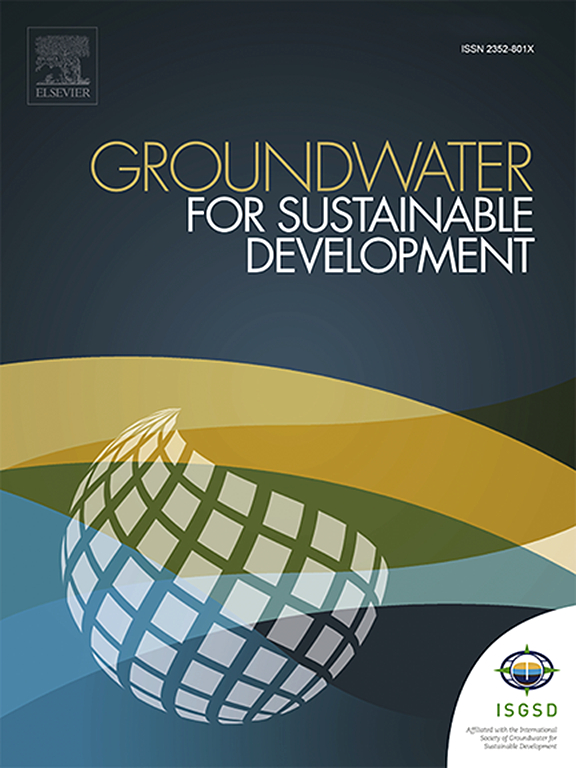利用钻孔抽水实验和地球物理数据评估基岩含水层的生产力,促进撒哈拉以南非洲地下水的可持续开发
IF 4.9
Q2 ENGINEERING, ENVIRONMENTAL
引用次数: 0
摘要
要确保撒哈拉以南非洲地区基底复杂地区全年都有地下水可用,就必须将地下水资源的勘探、开发和管理战略精心结合起来。研究利用钻孔抽水实验、地球物理勘测和撒哈拉以南非洲奥帕克油田岩性记录等数据,从单位时间内的出水量、含水层渗透率、导水性、比容和含水层厚度等方面对撒哈拉以南非洲地区基底含水层的生产力进行了评估。研究结果被用来将撒哈拉以南非洲的基底复合含水层分为三类:微丰水层、低丰水层和中丰水层。研究发现,风化带和断裂带是地下水储存的亮点,含水层的生产力与地形和风化带的厚度相关。大多数位于低地形高处的钻孔被发现具有最高的地下水排放量、渗透率和水力传导率。此外,研究还表明,用于估算含水层特性的常用模型并不适合地下室复杂含水层。与抽水测试结果相比,模型的结果被夸大了。在基底复杂地形中出现的干洞或性能不佳的水井可能就是夸大的结果。因此,我们提出并测试了两个新颖的定量模型,用于评估 SSA 地下含水层的生产力参数,以优化地下水开发的选址。新定量模型计算出的含水层生产力图与抽水试验结果惊人地相似,证实了新定量模型的适当性。为从本研究确定的三类含水层中抽取地下水的钻孔推荐了适当的抽水设备、水泵运行时间和安装深度。本文章由计算机程序翻译,如有差异,请以英文原文为准。

Evaluating the productivity of basement rock aquifers for sustainable groundwater development in sub-Sahara Africa using borehole pumping experiments and geophysical data
Ensuring all-year-round groundwater availability in the basement complex regions of sub-Sahara Africa requires careful combinations of strategies for exploration, development, and management of groundwater resources. The productivity of the basement aquifer of sub-Sahara Africa, SSA, was evaluated in terms of the volume of water produced per unit time, the aquifer transmissivity, hydraulic conductivity, specific capacity, and the thickness of the water-bearing zones using a suit of data from borehole pumping experiments, geophysical surveys, and lithologic logs from Opaque Field in sub-Sahara Africa. Findings from the study have been used to classify the basement complex aquifers of sub-Sahara Africa into three categories: marginally productive, low productive, and moderately productive. Weathered and fractured zones were found to be bright spots for groundwater storage, and aquifer productivity correlates with topography and the thickness of the weather zones. Most of the boreholes located on the low topographic heights were found to have the highest groundwater discharge, transmissivity, and hydraulic conductivity. Further, the study showed that the popular models used for estimating aquifer properties are unsuitable for basement complex aquifers. The results of the models are exaggerated when compared to the pumping test results. Cases of dry holes or poorly performing wells in the basement complex terrain may be attributed to the exaggeration. Consequently, two new and novel quantitative models were proposed and tested for evaluating the productivity parameters of basement aquifers of SSA for optimal selection of sites for groundwater development. The aquifer productivity maps computed with the new quantitative models show striking similarities to those computed from the pumping tests results and confirmed the appropriateness of the new quantitative models. The appropriate pumping device, pump operation time, and installation depth were recommended for the boreholes producing groundwater from the three categories of aquifers identified in this study.
求助全文
通过发布文献求助,成功后即可免费获取论文全文。
去求助
来源期刊

Groundwater for Sustainable Development
Social Sciences-Geography, Planning and Development
CiteScore
11.50
自引率
10.20%
发文量
152
期刊介绍:
Groundwater for Sustainable Development is directed to different stakeholders and professionals, including government and non-governmental organizations, international funding agencies, universities, public water institutions, public health and other public/private sector professionals, and other relevant institutions. It is aimed at professionals, academics and students in the fields of disciplines such as: groundwater and its connection to surface hydrology and environment, soil sciences, engineering, ecology, microbiology, atmospheric sciences, analytical chemistry, hydro-engineering, water technology, environmental ethics, economics, public health, policy, as well as social sciences, legal disciplines, or any other area connected with water issues. The objectives of this journal are to facilitate: • The improvement of effective and sustainable management of water resources across the globe. • The improvement of human access to groundwater resources in adequate quantity and good quality. • The meeting of the increasing demand for drinking and irrigation water needed for food security to contribute to a social and economically sound human development. • The creation of a global inter- and multidisciplinary platform and forum to improve our understanding of groundwater resources and to advocate their effective and sustainable management and protection against contamination. • Interdisciplinary information exchange and to stimulate scientific research in the fields of groundwater related sciences and social and health sciences required to achieve the United Nations Millennium Development Goals for sustainable development.
 求助内容:
求助内容: 应助结果提醒方式:
应助结果提醒方式:


